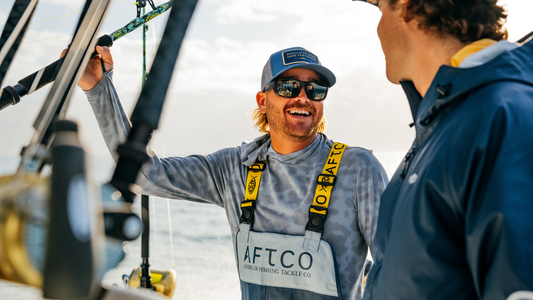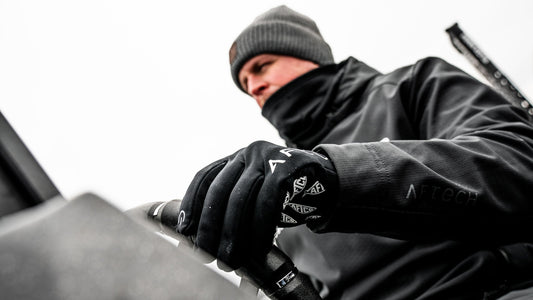
Types of Fishing Line - How to Choose
Choosing the right fishing line for how you fish is one of your most important fishing decisions. After all, your fishing line is the only connection to your fish of a lifetime.
Between monofilament, fluorocarbon, and braid, the possible combinations of fishing line types seem endless. In this article, we’ll cover the advantages and disadvantages of each type of line so you will be ready for your next day on the water.
Monofilament Line

Key Characteristics
- High stretch
- Low visibility
- Easy to handle
- Low cost
Although there isn’t one line material that is perfect for all fishing situations and conditions, monofilament fishing line comes close. Because of its inherent characteristics, it became popular in the 1960s and is still the line choice for many anglers today.
Consisting of a single strand of extruded nylon, monofilament line is more than anything else forgiving-it has more stretch than other lines. This stretch gives monofilament the ability to absorb shocks, helping to prevent break-offs when a hooked fish shakes its head, thrashes, or changes directions rapidly. This shock-absorbing property is highlighted by its use in offshore trolling, where aggressive strikes are not unusual.
Monofilament line is flexible and limber, which aids in casting and makes knot tying easy. It yields good knot strength over a wide variety of common fishing knots.
Mono is versatile and is used with spinning, baitcasting, and conventional revolving spool reels. It is widely available and used for most types of fishing, from spin fishing for small panfish to offshore trolling for large pelagics. With a lower cost than other line types, it is a popular choice, especially for beginners. Monofilament line is commonly used as a mainline and as leader material.
Abrasion resistance is a key factor to consider when selecting fishing line and monofilament rates high. It’s more abrasion-resistant than braid but less resistant than fluorocarbon.
Being slightly heavier than water, mono line sinks very slowly, making it an excellent choice for many types of fishing. Monofilament is relatively clear and, therefore, not very visible underwater.
While mono’s ability to stretch is advantageous in some situations, it is a disadvantage in others. Its stretchiness limits your ability to feel what is happening at the end of the line and can cause you to miss subtle strikes and pick-ups. This stretch also slows the speed and impact of your hook sets.
Another disadvantage of a monofilament line is its thickness. It is slightly thicker than fluorocarbon and significantly thicker than braid of the same strength. Because the monofilament line is thicker, it has more wind and water resistance and provides less line capacity on a reel than fluorocarbon or braid.
Finally, monofilament line is susceptible to damage by sunlight. As a result, it needs to be replaced more frequently than other line types.
Fluorocarbon Line

Key Characteristics
- Extremely low visibility
- Abrasion resistance
- Low stretch
- Sinks (denser than water)
Fluorocarbon fishing line, like monofilament, is a single-strand line. It is an extruded fluoropolymer, as opposed to monofilament, which is extruded nylon.
Fluorocarbon is denser than mono, which gives it some desirable qualities. Sinking more quickly than mono, it is popular for use with sub-surface lures and baits. The denseness of fluorocarbon also equates to a harder and more abrasion-resistant line than monofilament.
When the water is clear, or the target fish species are leader-shy, the fluorocarbon line is the material to use. Fluorocarbon makes an exceptional leader material that is nearly invisible and very abrasion-resistant. One of my favorites is AFTCO Saiko Pro Fluorocarbon Leader.
The lack of stretch in fluorocarbon line allows you to feel subtle strikes and provides great sensitivity overall. This lack of stretch, along with its sinking characteristics, makes it an outstanding line for deep freshwater or saltwater bottom fishing.
While fluorocarbon line produces adequate knot strength, it is inherently stiff and difficult to tie, especially when using heavier lines. Because of this stiffness and memory, it is more difficult to handle and cast than monofilament.
Fluorocarbon line is suitable for spinning and conventional reels. Its primary use as the main line is for bass fishing with sub-surface baits. The sinking action of fluorocarbon allows baits to run deeper than with other lines.
Braided Line

Key Characteristics
- Doesn't stretch-extremely sensitive
- Much thinner than all other lines
- Visible underwater
- Less abrasion resistant than other lines
For many anglers, braid is the go-to line. Although braided fishing lines have been available for decades, recent technological advances have created superior products that continue to gain in popularity. As its name implies, braid consists of woven polyethylene fibers, usually containing 4 to 16 strands.
The two significant advantages of braided fishing line are the lack of stretch and small diameter. This lack of stretch provides unrivaled sensitivity so anglers can feel extremely soft strikes, even in deep water.
Because it is thinner than monofilament and fluorocarbon, spooling a reel with braid significantly increases line capacity. It also allows an angler to fish with a much stronger line of an equivalent diameter.
Line diameters of popular 20-pound lines (inches):
- Mono 0.017
- Fluorocarbon 0.016
- Braid 0.007
Relative Size of 20 pound Test Lines

Not surprisingly, a thinner line has less wind resistance than a thicker one, resulting in increased casting distance. Smaller diameter lines also have less water resistance, which is an advantage, especially when fishing deep water or in heavy currents.
Braid is not particularly abrasion resistant; if individual strands that make up the line get nicked or damaged, the overall line strength can be significantly reduced.
It floats, making it a wise choice for top-water and shallow-water baits. Braided line is used on both spinning and revolving spool reels. It can be used for most types of fishing and is sold in strengths from ultra-light to several hundred-pound tests. It isn’t used as a leader material but can be tied directly to the lure or hook if line visibility isn’t a concern.
Braided line is susceptible to wind knots that form when casting. They can be difficult and frustrating, especially for beginners.
Specific knots are required when tying braided line. This line has little friction when wrapped around itself, so knots used with braid tend to be more complex than those used with other lines. Properly tied knots in braid provide exceptional strength. Learn how to tie some essential knots here.
Braid is very visible underwater, so mono or fluorocarbon leaders should be used in clear water situations.
Fishing Line Characteristics
|
|
Mono |
Fluorocarbon |
Braid |
|
Stretch |
Very stretchy |
Limited stretch |
Minimal Stretch |
|
Visibility |
Somewhat visible |
Almost invisible |
Very visible |
|
Thickness |
Bulky |
Slightly thinner than mono |
Extremely thin |
|
Abrasion Resistance |
Good |
Exceptionally good |
Good but individual strands damage easily |
|
Knot Strength |
Good |
Good |
Good but requires specific knots |
Skill Level & Techniques
|
|
Mono |
Fluorocarbon |
Braid |
|
Cost |
Least expensive |
More expensive than mono |
More expensive than mono |
|
Durability-Longevity |
Replace at least once a year |
Can last several years |
Can last several years |
|
Skill Level |
Beginner |
Intermediate |
Intermediate to advanced |
|
Technique |
Spinning, baitcasting, and conventional reels |
Used most often on baitcasting reels |
Spinning, baitcasting, and conventional reels |
|
Weather |
All weather conditions |
All weather conditions |
Not for use in freezing temperatures |
Fishing Line Selection FAQs
What is the best fishing line for a beginner? Monofilament is the best line for anglers just starting. It is inexpensive, casts well, has good knot strength, and has stretch, which makes it forgiving.
What fishing line should I use in ultra-clear water? Fluorocarbon is the most transparent line and is the choice for clear water. Many anglers who use monofilament or braid as mainline often use it with fluorocarbon for leaders.
What fishing line should I use for topwater lures? When fishing topwater baits or shallow-running lures, either braid or monofilament line should be used. These lines float or sink very slowly and do not negatively affect the bait's action.
What fishing line weight should I use? Use the heaviest line available that gives your bait proper action, allows you to cast and fish comfortably, and provides a reasonable chance to land the size and species of the fish you are pursuing.
What is the best fishing line for baitcasting reels? Most beginners start with mono. More experienced bass anglers tend to use fluorocarbon or braid based on water clarity, lure selection, need for abrasion resistance, and strength requirements.
I’m just getting into bass fishing. What is the best all-around fishing line for my first rod and reel setup? Start with 17-pound test monofilament. It will allow you to fish many situations and conditions. Check out our freshwater fishing blog for beginners to learn more.
What color fishing line should I use? Fluorocarbon is less visible than mono, which is less visible than braid. Line color doesn't matter much if you are fishing in dirty water or deep water.
Use clear fluorocarbon or mono line in clear or shallow water. When fishing with braid, choose a color that matches the environment: moss green or gray for dirty water and blue for offshore. If you fish with braid or brightly colored mono or fluorocarbon in clear water, tie on a monofilament or fluorocarbon leader.
How often should I replace my fishing line? Fishing line wears out faster the more it is used. All lines deteriorate when exposed to the sun’s ultraviolet rays, with monofilament line being the most susceptible to UV damage. Monofilament should be replaced at a minimum every year, while fluorocarbon and braid can last for several years.
Check your fishing line for fine abrasions, discoloration, and changes in suppleness. Test knot strength periodically and look for kinks and frayed sections. These are signs that the line is worn out and should be replaced.
Using this guide, you can select a fishing line that best suits your needs based on how you fish and the species you target. Confidence in your gear makes the fishing experience more enjoyable and choosing the right fishing line is a big part of that. Remember, your line connects you to the fish of a lifetime!
Author's Profile: John Flanagan
John Flanagan writes about fishing, boating, business, and coastal lifestyle. A life-long fisherman, licensed captain and aficionado of all things coastal, he pursues his passions on the coastal waters of North Carolina. Learn more here.





